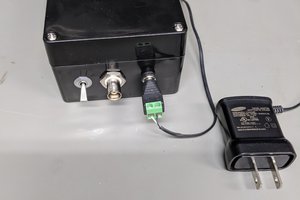Using a digital approach would have involved adding a small microcontroller in the area near the sensors, and encoding a serial digital signal to send up the telescope tube, with appropriate synchronous pulses, data, and check sums, which then would undergo decoding at the CPU. This approach would have required some sort of reset provision because the telescopes need to operate independently for months, and of course the CPU might crash occasionally. Furthermore, those serial digital signals would have undesirable switching noise on them, potentially interfering with sensitive analog signals elsewhere in the system.
The main telescope CPU would then have had to spend time grabbing, decoding, and synchronizing the signals, (since the one serial port is taken up by other parts of the circuit), taking up more time. In addition, we would have had to have written some messy bit-banging code: not a huge challenge—but not a simple or elegant one, either.
Instead, this all-analog approach uses a variation on a simple analog adder circuit in which each sensor contributes to the output voltage. Taking the basic binary idea that one sensor could add ± 1; the next, ±2; and the third, ±4, the approach uniquely represents each state. The different sensors achieve this different weighting by having their output voltages go through different input resisters to the summing junction of the analog adder circuit.
The basic requirements are a voltage reference, some op amps, and a summing junction. This application uses IC4, a Texas Instruments REF3040 voltage reference, which has an excellent output tolerance of 0.2%, yet costs only approximately $1 . This reference generates a voltage of 4.096V and produces enough current to run the op amps, which run rail to rail to within a few millivolts. Most of us who grew up with the classic 741 will be amazed that these recently released op amps can get within MILLIVOLTS of there supply voltages, and have adequate output current draw to power the adder resistors! Be careful, however: Not many op amps actually run "rail to rail", and some “rail-to-rail” op amps have insufficient current drive near the rails! There are from Analog Devices, an 8532, which can supply gallons of current, and an 8606. Note that the current drive requirement is roughly (Vref - Vref/2) divided by the value of the resistor into the summing junction, since the summing junction is held at Vref/2.
Note that the op-amps also function as comparators, using Vref/2 to determine the state of the sensors, and these precision op amps convert the rough and inaccurate sensor output voltages to precise values ! This circuit uses 0.1%-precision resistors, which are uncommon but quite inexpensive - only about 20 cents each. I use two 10-kΩ .1% resistors in series and two in parallel to create the 20- and 5-kΩ resistances that you see in the schematic in the summing junction. In using the same values of resistors, the assembly and bill of materials are simpler - AND the precision is generally speaking better, because the distributions of actual resistor values around the "ideal" resistor value tend to cancel out. Table 1 lists the predicted output voltages.
| TABLE 1: Predicted output voltage with various input switch configurations: | ||||
| Input Switch 1 | Input Switch 2 | Input Switch 3 | Output Voltage | |
| 0 | 0 | 0 | 0.256 | |
| 0 | 0 | 1 | 0.768 | |
| 0 | 1 | 0 | 1.28 | |
| 0 | 1 | 1 | 1.792 | |
| 1 | 0 | 0 | 2.304 | |
| 1 | 0 | 1 | 2.816 | |
| 1 | 1 | 0 | 3.328 | |
| 1 | 1 | 1 | 3.84 |
Tests with a precision voltmeter show that all output voltages were all within 1 mV of the predicted output values. The...
Read more »
 Mitsuru Yamada
Mitsuru Yamada
 Burkhard Kainka
Burkhard Kainka
 W4KRL
W4KRL
 Mario Ninic
Mario Ninic